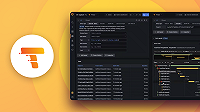Configure TraceQL metrics
Note
TraceQL metrics is an experimental feature. Engineering and on-call support is not available. Documentation is either limited or not provided outside of code comments. No SLA is provided. Enable the feature toggle in Grafana to use this feature. Contact Grafana Support to enable this feature in Grafana Cloud.
TraceQL language provides metrics queries as an experimental feature. Metric queries extend trace queries by applying a function to trace query results. This powerful feature creates metrics from traces, much in the same way that LogQL metric queries create metrics from logs.
For more information about available queries, refer to TraceQL metrics queries.
Before you begin
To use the metrics generated from traces, you need to:
- Set the
local-blocksprocessor to active in yourmetrics-generatorconfiguration - Configure a Tempo data source in Grafana or Grafana Cloud
- Access Grafana Cloud or Grafana version 10.4 or newer
Activate and configure the local-blocks processor
To activate the local-blocks processor for all users, add it to the list of processors in the overrides block of your Tempo configuration.
# Global overrides configuration.
overrides:
metrics_generator_processors: ['local-blocks']To configure the processor per tenant, use the metrics_generator.processor override.
For more information about overrides, refer to Standard overrides.
Configure the processor
Next, configure the local-blocks processor to record all spans for TraceQL metrics.
Here is an example configuration:
metrics_generator:
processor:
local_blocks:
filter_server_spans: false
storage:
path: /var/tempo/generator/wal
traces_storage:
path: /var/tempo/generator/tracesIf you configured Tempo using the tempo-distributed Helm chart, you can also set traces_storage using your values.yaml file. Refer to the Helm chart for an example.
Refer to the metrics-generator configuration documentation for more information.
Evaluate query timeouts
Because of their expensive nature, these queries can take a long time to run. As such, consider increasing the timeouts in various places of the system to allow enough time for the data to be returned.
Consider these areas when raising timeouts:
- Any proxy in front of Grafana
- Grafana data source for Prometheus pointing at Tempo
- Tempo configuration
querier.search.query_timeoutserver.http_server_read_timeoutserver.http_server_write_timeout
Set TraceQL metrics query options
The query_frontend.metrics configuration block controls all TraceQL metrics queries.
The configuration depends on the environment.
Note
The default maximum time range for a metrics query is 3 hours, configured using the
query_frontend.metrics.max_durationparameter.This is different to the default TraceQL maximum time range of 168 hours (7 days).
For example, in a cloud environment, smaller jobs with more concurrency may be desired due to the nature of scale on the backend.
query_frontend:
metrics:
concurrent_jobs: 1000
target_bytes_per_job: 2.25e+08 # ~225MB
interval: 30m0sFor an on-prem backend, you can improve query times by lowering the concurrency, while increasing the job size.
query_frontend:
metrics:
concurrent_jobs: 8
target_bytes_per_job: 1.25e+09 # ~1.25GB

